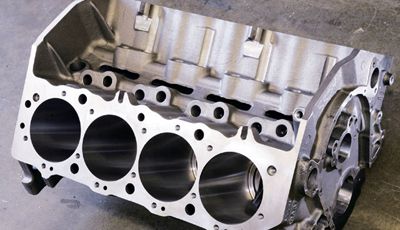
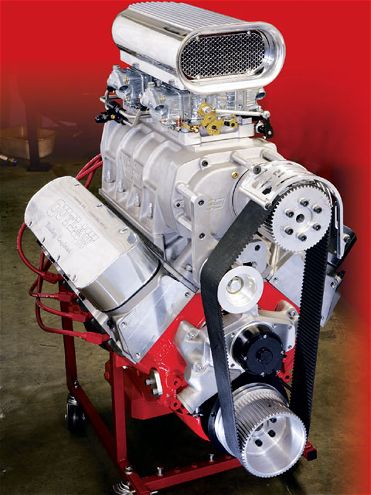
If a big-block Chevy has not figured into your life yet, you probably won't understand it until you experience the apparent ease with which it will deliver a big fat output. Whereas a small-block always seems so busy on the dyno, a big-block just grunts it out, seemingly without any real effort. Adding a blower to a big-block just reinforces the whole "in your face" deal. Apart from the intimidation factor, the effortless output was why Outlaw Racing customer Alex Maldonado chose to go the blown big-block route for his '57 Chevy-it's a big, heavy car. With a basic game plan in mind, it was time for Alex to do some source searching.
Anytime we talk blown big-block, the word "budget" can no longer be used with the word "low." But that should not imply a build cost looking like a monetary black hole either. Choose an engine builder who has expertise at off-the-shelf parts selection for functional combinations, and an exotic "catalog" big-block like this one could be yours for under $21,000. But for many, $21,000 is still a lot of cash. That said, it becomes even more important to choose a reputable engine builder who has experience with such builds, and one who stands behind his work.
Andy Mitchell is the boss at the Upland, California-based Outlaw Racing Engines. It has to be said that it's easy to stick the word "Racing" into a company business name. Sometimes for the business' owner, it's no more than a flight of imagination. When contemplating an exotic high-performance engine where $21,000 is involved, success on the track looks like it should figure prominently in the decision making. Visit www.outlawracingengines.com, and you will see some of the race-winning, record-setting cars powered by Andy's engines. With a clean, smart, well-equipped full-service shop to back his efforts, Alex figured Andy looked like the guy to build his engine.
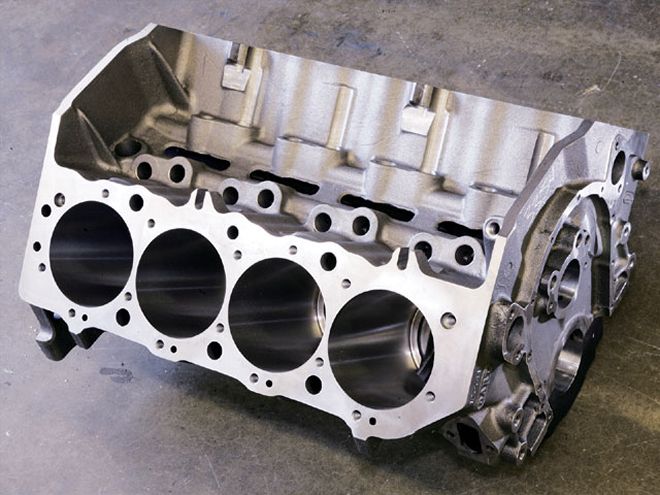 The big-bore Dart block selected for the job has many upgrades that the stock-block does not have.
The big-bore Dart block selected for the job has many upgrades that the stock-block does not have.
The Bottom End
A few years back, the big-block Chevy went through a popularity resurgence. This has resulted in even stock-blocks commanding premium asking prices. We have just gone through this routine ourselves, shelling out $600 for an average core 454 block. By the time we found a good late-model block, and had it machined, the bill was well into four figures. At the end of the day, we still only had a stock block. Andy's advice here is spend the money, get a Dart block, and enjoy the insurance of super strength that goes with it. For something over a grand more than stock, you get a new block with a 4.5-inch bore that will go to 4.625 if necessary. That's up to 3/8 inch bigger than stock. Additionally, the block is good for a couple of thousand horsepower, and then some. It also has the sort of reliability enhancing upgrades you would like to have on a stock-block, such as priority main oiling (unlike stock, oil is delivered to the mains first, then lifters). Also, a re-routed oil crossover passage eliminates internal oil leakage at the distributor.
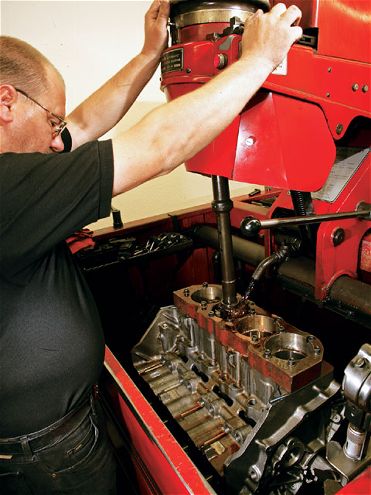 Other than finishing the bores to suit the pistons, the Dart block comes fully machined in all other respects to race-engine limits.
Other than finishing the bores to suit the pistons, the Dart block comes fully machined in all other respects to race-engine limits.
For a crank, a Callies Dragonslayer was chosen. These are best described as an all-American-made, heavy duty sportsman crank. Callies makes these cranks with a stock 2.200-inch rod journal, with stroke options of 4.000, 4.250, and 4.500 inches. With top-grade 4340 steel, a tough core, and deep-case heat treat, these cranks are about ready for anything. For shock-and-awe value, it has the ability-if required-to turn a lot of rpm. In this case, the 4-inch stroke was used, and with the 4.5-inch bore, delivered 509 inches.
Rods for this 509 took the form of a set of Howards billet BR series. This American-made 6.8-inch long two-rib cap design is (at a shade over 780 grams) lighter than you would expect of a heavy-duty rod. Riding on the rods is a set of JE's finest. These off-the-shelf pistons worked out perfectly in the tall-deck Dart block, with the 4-inch stroke and the 6.8-inch-long Howards rods providing a respectable 1.395-inch compression height. Keeping the wristpin out of the oil ring on a street engine of this power level will pay dividends in longevity for years to come. With the 28cc dish pistons just shy of flush, plus a flat mill of some .010 inch on the heads, resulted in a boost-friendly 8.2:1 compression ratio. With a compression ratio this conservative, there was room to considerably move the boost in an upward direction at a later date. The JE pistons were equipped with Total Seal Advanced Profile Gapless stainless steel rings to ensure a long life and gas-tight seal when that boosted charge lights off. Total Seal rings are, among some engine builders, a controversial subject. Andy's viewpoint: "We go faster with them, and our team car is slaughtering the opposition on the track."
Feeding the internals the necessary oil flow and pressure was a Melling high-volume pump, and to control the inevitable oil surge from high g acceleration, a six-quart pan from Big B Auto was used.
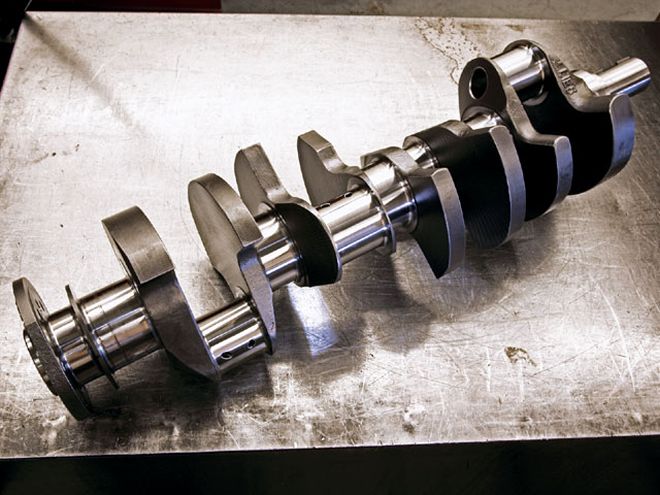 The Callies Dragonslayer crank used in our 509 represents good American engineering at a sportsman price. Top-grade material and a comprehensive heat treat are all part of the deal.
The Callies Dragonslayer crank used in our 509 represents good American engineering at a sportsman price. Top-grade material and a comprehensive heat treat are all part of the deal.
Power Production Parts
We can liken the bottom end of this engine to a "case." And with the parts used, we have a case that can reliably contain the pressures and mechanically generated dynamic forces that are likely to come about during the business of producing immense power figures. It's time to look at just what power producing components Andy chose for this build.
Starting at the top is a pair of blower-spec 750 Holleys, which will be fed a diet of clean air courtesy of a Hilborn filter-equipped air scoop. Good filtration will ensure the close tolerances of the blower rotors are not compromised, and the rings and bores will have long lives.
The 750 Holleys used were of a blower-specific design. The main difference is the power valve is referenced to the manifold vacuum/pressure under the supercharger, not the area under the carbs before the supercharger. As far as the fuel delivery curves at part and wide-open throttle are concerned, Holley went through a series of calibration tests at its facility on these Weiand 6- and 8-71 blowers. An advantage of the calibration of a blower carb is that possible calibration changes, from one blower to another, are very minimal, as the induction pulses are unique to the blower, not the engine. This means once the factory calibrations are done, they won't change significantly from one GMC-blown application to another.
Because the form and amplitude of the blower pulses are measurably different than piston-induced pulses in a normally aspirated engine, the fuel delivery calibrations for these blower carbs are substantially different. To achieve the desired fuel curves in idle, transition, and wide-open mode, the main jets, air correctors, and emulsion well holes had to be re-evaluated. Just how well these near-universal calibrations would work would be revealed when this 509 hit the dyno.
The Blower
Ultimately, it's the presence of that big 8-71 blower that gives this 509 its menacing appearance and sound. Originally designed as the scavenge pump for a GMC two-cycle diesel, this blower found notoriety when the top Gas and Fuel dragster guys started using it in the late '50s and early '60s. It has long gone out of production, and what Weiand now builds is an updated version from all-new tooling. It is in fact an improved replica of the world's most notorious blower, and falls into a category known as a "positive displacement" supercharger. If we exclude leakage past the rotors, that means (unlike a turbo) it moves a certain number of cubic feet of air per revolution, regardless of rpm. What this does is not only produce boost everywhere in the rpm range, but also produces it instantly, on demand. When everything is just right, throttle response follows suit, meaning that it's near instant. You have to believe those Top Fuel guys used this blower all those years for a reason. Maybe it's because it made them fast!
Heads
Although iron heads can be used with a supercharger, aluminum heads have the advantage of running cooler, and with less troublesome detonation-inducing hot spots. This means they are able to accommodate a combination of more boost and higher compression. The heads chosen for the job were as-cast RHS 320cc port heads (PN 11001). These are the smaller of the two port sizes that RHS offers for the big-block. When a blower factors into the equation of a high-output street motor, the port size does not need to be configured so much for the top end output because the blower will, to a certain extent, take care of that with boost. For part-throttle driveability, there are advantages toward the use of a smaller port, and that is why this particular spec of head was chosen.
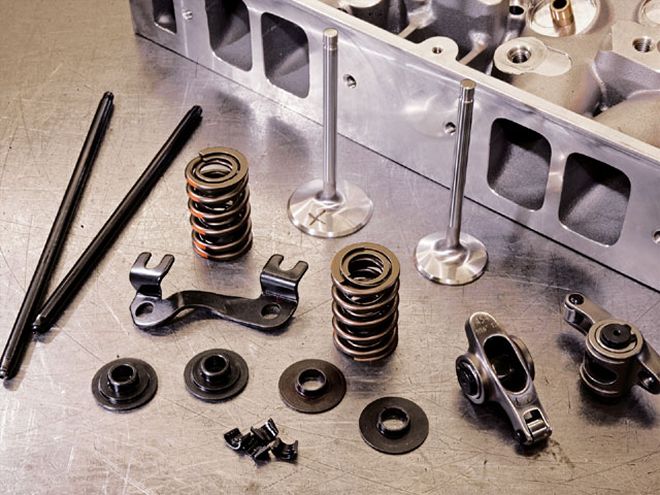 The valvetrain components are used along with COMP's Xtreme Energy hydraulic roller cam.
The valvetrain components are used along with COMP's Xtreme Energy hydraulic roller cam.
Valvetrain
Alex wanted a ruthlessly fast street machine, not an all-out racer. That meant selecting a hydraulic cam that was spec'd to deliver good idle, with a touch of mean race-engine lope. The cam spec developed by Andy uses COMP's popular Xtreme Energy hydraulic roller profiles. For a street cam, the intake (PN 3370) has a seemingly huge 303 degrees of off-the-seat duration. The exhaust profile (PN 3371) has 309 degrees, and at .050-inch lift, the cam lobes deliver 248 and 254 degrees duration, respectively.
Unlike a solid roller, these COMP Xtreme profiles have a relatively gentle initial opening, so compared to a solid roller with the same off-the-seat duration, they act a lot shorter. Once these profiles have taken up all the valvetrain preload, they get with the program. Another key factor for a big-block Chevy cam is having a respectably high valve lift. With the .380-inch lobe lift from these profiles, a valve lift of .646 inch is generated with the 1.7 ratio PRW stainless roller rockers used. Also working toward streetability is the fact that a blower-spec cam should, along with slightly less advance, have a wider lobe separation angle than the equivalent optimally spec'd cam for a normally aspirated engine. Too much overlap means the boosted intake charge will not only scavenge the combustion chamber, but go right on out the exhaust port. The wide 114-degree LCA chosen by Andy has a significant influence toward making the cam more civilized for the street. With the 114-degree LCA, the overlap is a very streetable 78 degrees. To give you small-block guys a reference point, it would be like running a hydraulic flat-tappet cam of 284 off-the-seat degrees in a 350. It's big, but far from outlandish.
The business of transmitting the cam motion to the valves starts with a set of COMP's plus .300-inch-long Pro Magnum hydraulic rollers. The extra lifter length here is needed to clear the Dart block's taller lifter bores. The lifter motion reaches the rockers via a set of Manley 3/8-inch diameter pushrods. The rockers are PRW's ultra-stiff stainless items, which unlike aluminum rockers, have a virtually infinite fatigue life. This makes them good for the street where millions of cycles are involved.
Springs for a hydraulic valvetrain can be critical. Too little seat pressure and seat bounce can rob an unbelievable amount of power. Too much, and the hydraulic internals of the lifter can collapse. Andy's choice of spring, a COMP 930, proved to be right on the money. With 153 lbs on the seat, and 382 lbs over the nose, the valvetrain ran flawlessly to the desired 6,600 rpm.
HYDRAULIC ROLLER CAM SPECS COMP Serial No.: K 6085-07 Grind: CB 3370B/3371B HR114+2 Gross valve lift: .647/.647 Duration @ .006: 303/309 Duration @ .050: 248/254 Lobe lift: .381/.381 Lobe separation: 114 degrees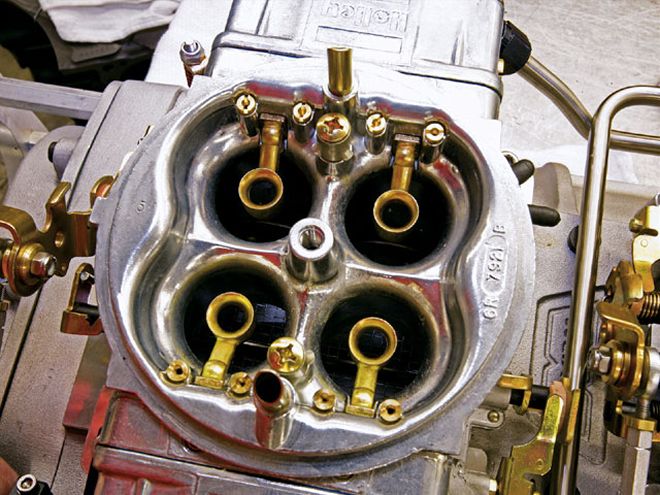 Take a look at all those air bleeds and such. These blower Holleys had just about every circuit recalibrated for the unique needs of a positive-displacement blower.
Take a look at all those air bleeds and such. These blower Holleys had just about every circuit recalibrated for the unique needs of a positive-displacement blower.
Ignition
Last item on the build is the ignition system. Andy used an MSD Pro Billet distributor with fixed timing. This might just have the scent of something a little too race-orientated, but the fact of the matter is that often a blown engine with a long-period cam has an advance curve requirement that is nearly a straight line. This engine falls into this category. The key issue to address is for the distributor to deliver a really healthy spark (not to mention physically clear the blower, which is in close proximity to the distributor).
Dyno Time
After a suitable break-in time, the 509 was given a nut-and-bolt service. This entails a check for any nuts/bolts that may have unseated after the break-in heat cycle. With that done, it was time to feed in a 50/50 mix of 114 octane with pump gas, and get acquainted with this engine's personality. It didn't take much in the way of running to establish this was the real deal. If Holley's claim that the carb calibration was a dead match for the blower, we'd soon find out. Those Holley's weren't close-they were right on. The only carb adjustment required was to set the idle adjustment screws and idle speed.
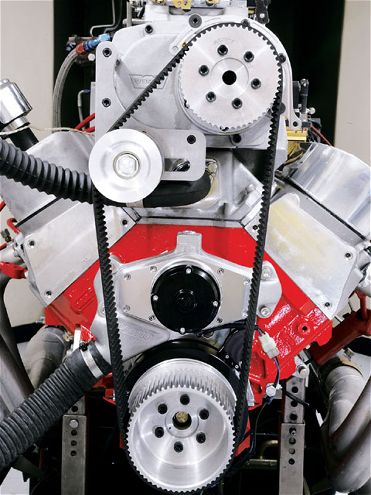 Blower speed is dictated by the ratio of the top to bottom pulley size. With a crank pulley of 61 teeth and a blower pulley of 54 teeth, the 8-71 is being overdriven by 13 percent.
Blower speed is dictated by the ratio of the top to bottom pulley size. With a crank pulley of 61 teeth and a blower pulley of 54 teeth, the 8-71 is being overdriven by 13 percent.
Because the carb calibration was on the money, this left only timing optimization. Andy started the tests at 28 degrees, as this was considered a really safe advance for an engine of this compression and boost, which registered a peak of 9.6 psi.
A run at 30 degrees netted more of everything, so 32 degrees was tried, and this proved a little better yet. Thirty-two degrees is quite a lot of timing for a blower motor, but when the very conservative compression ratio and boost are factored in, that number falls into place nicely. The bottom line here is that this engine could well deal with a blower overdrive that delivers as much as 15 lbs of boost.
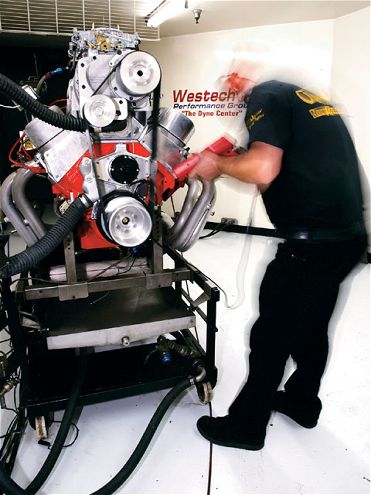 With the carbs right on, the only calibration required was to optimize the ignition timing.
With the carbs right on, the only calibration required was to optimize the ignition timing.
With the ignition timing set, this 509 was almost a contradiction in terms. It ran like a super-loud 850hp Swiss watch. Everyone was impressed with the way the Holley carbs performed. Andy commented that it would be hard to imagine that fuel injection would be any better than these blower carbs. The steady transition from small-part throttle cruise to a relatively wide-throttle position was smooth, and free of the lean stumble sometimes seen in non-blower-specific carb setups. As for throttle response, this was like watching a stick of dynamite go off at a safe distance. It made no difference how fast the throttle was opened, the engine kept up. The response was, in fact, so fast that the torque reaction looked like it would cause the engine to leap off the dyno stand. There were smiles all around, and especially on engine owner Alex's face. Is almost 850 hp going to be fast enough? Alex says: "Speed is relative. I just need to be faster than my relatives!"
ENGINE SPECIFICATIONS